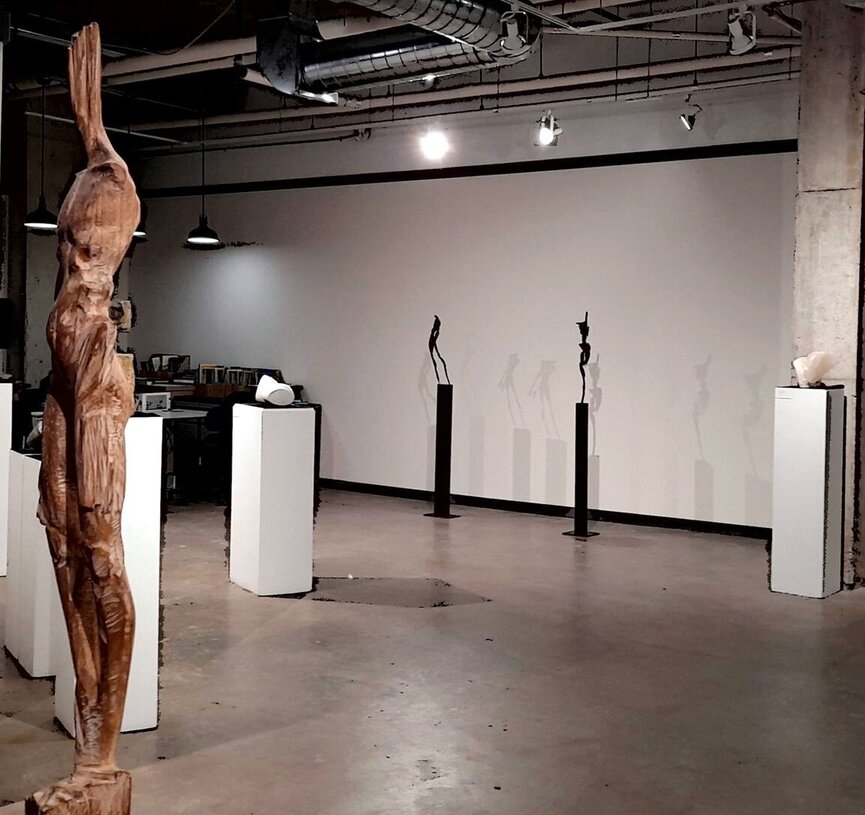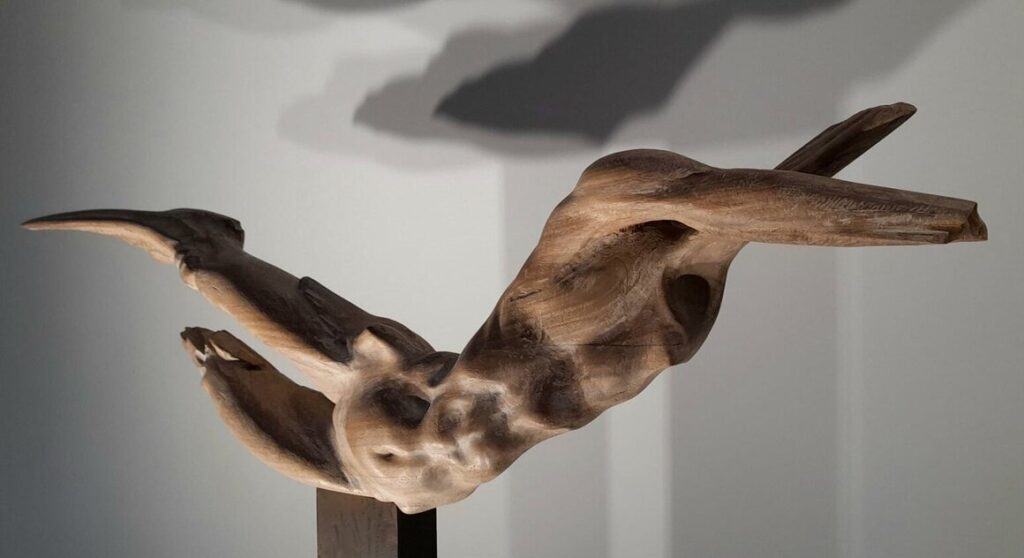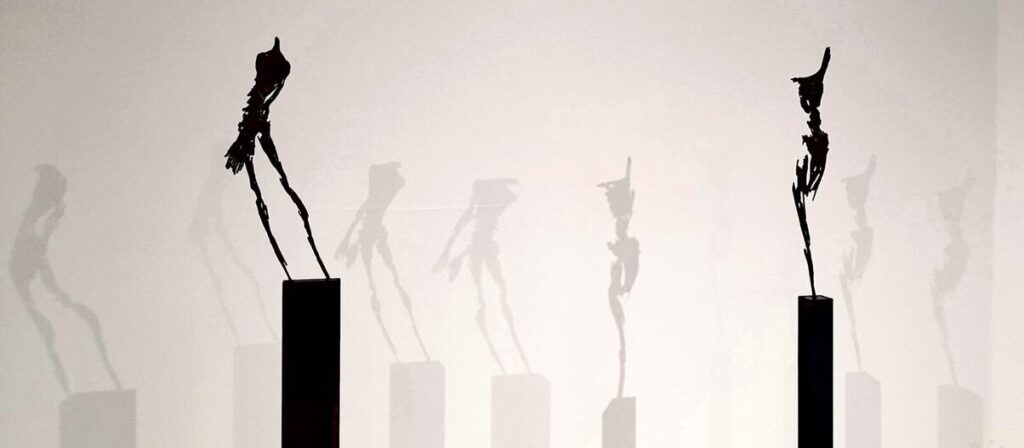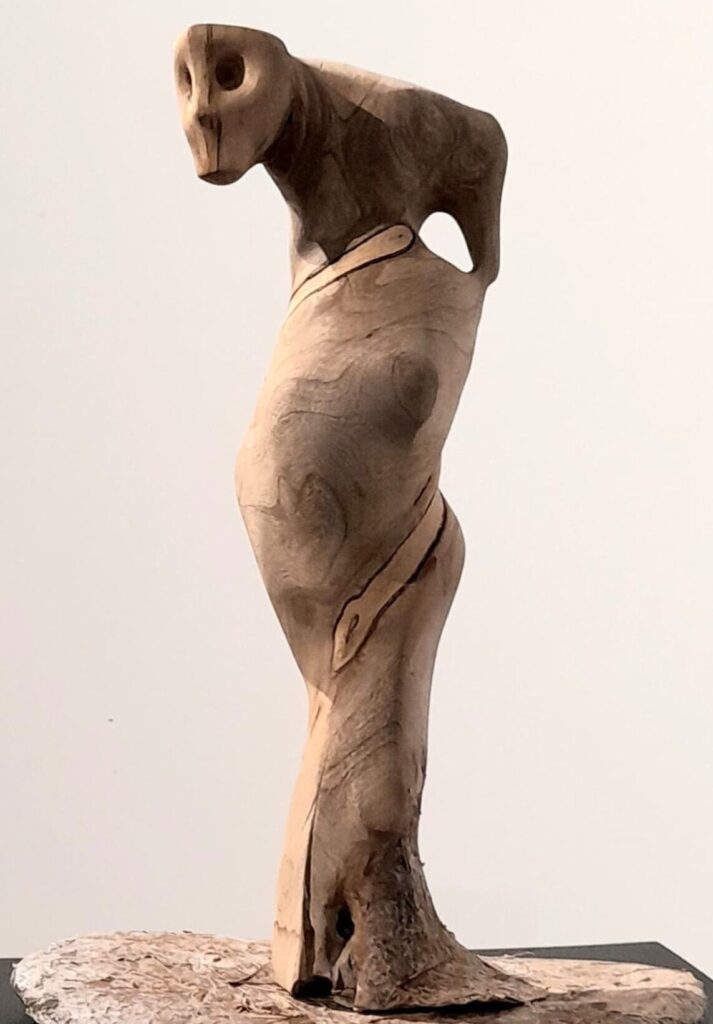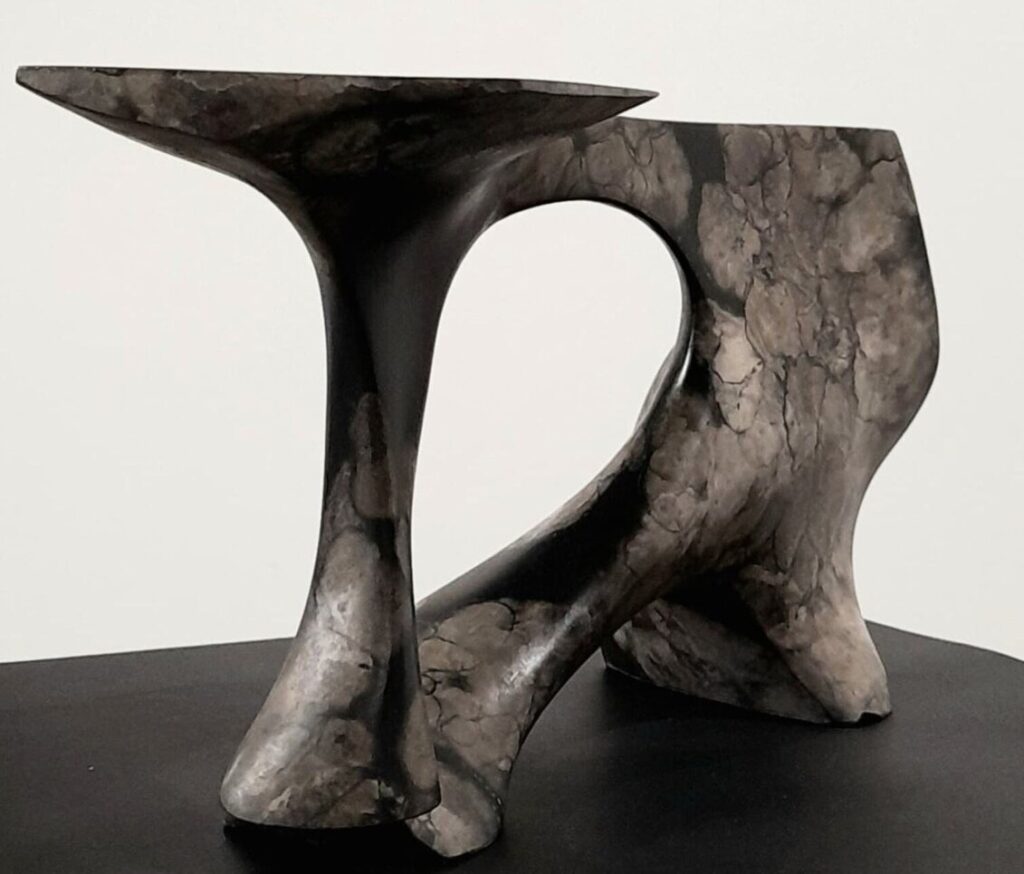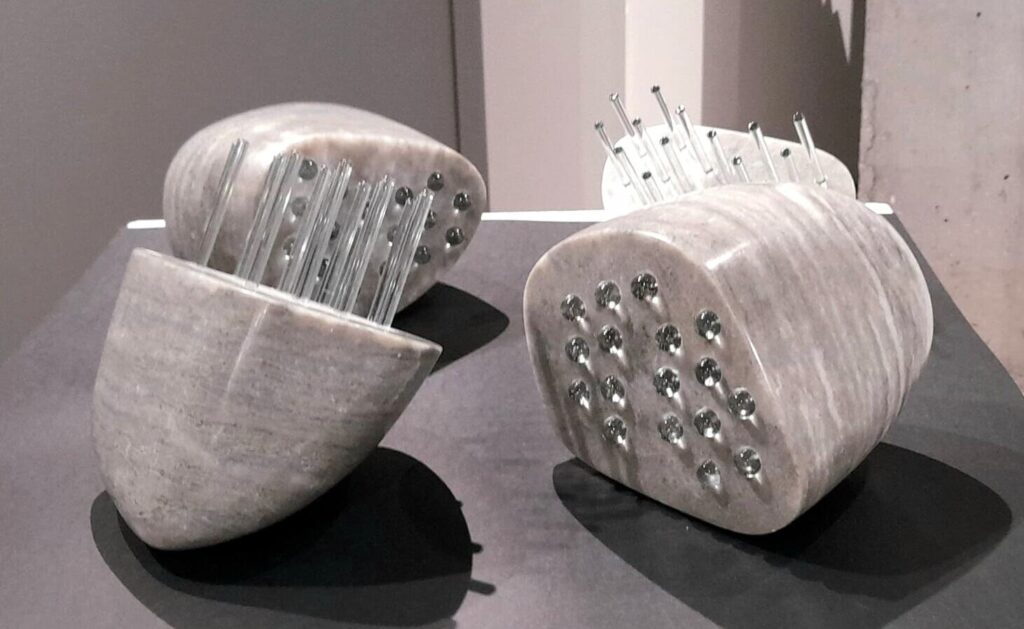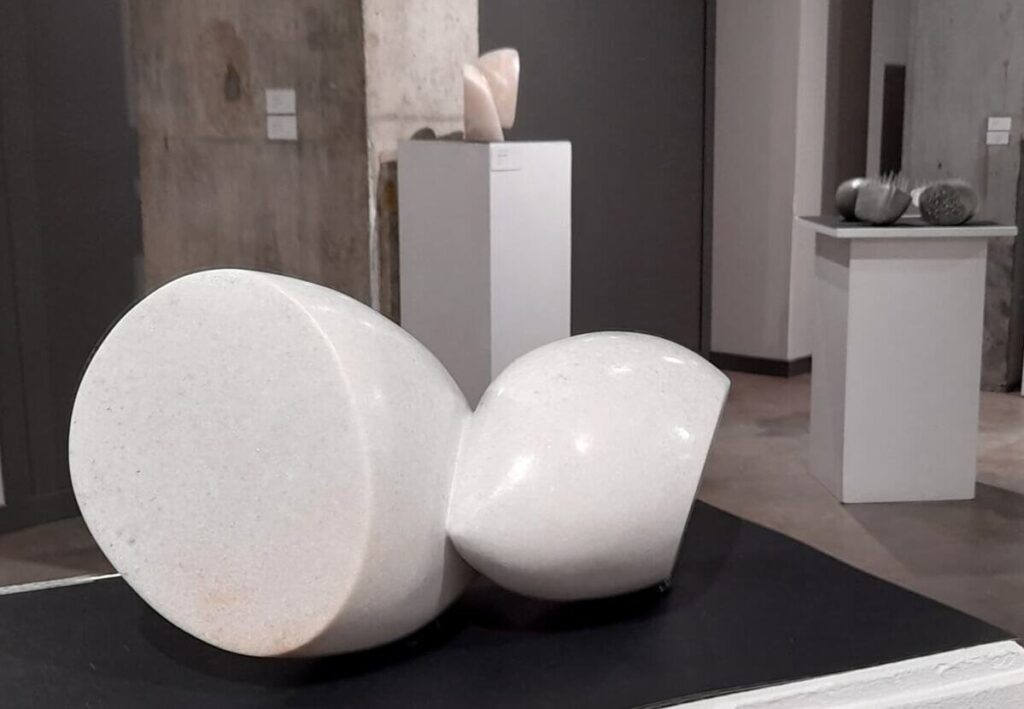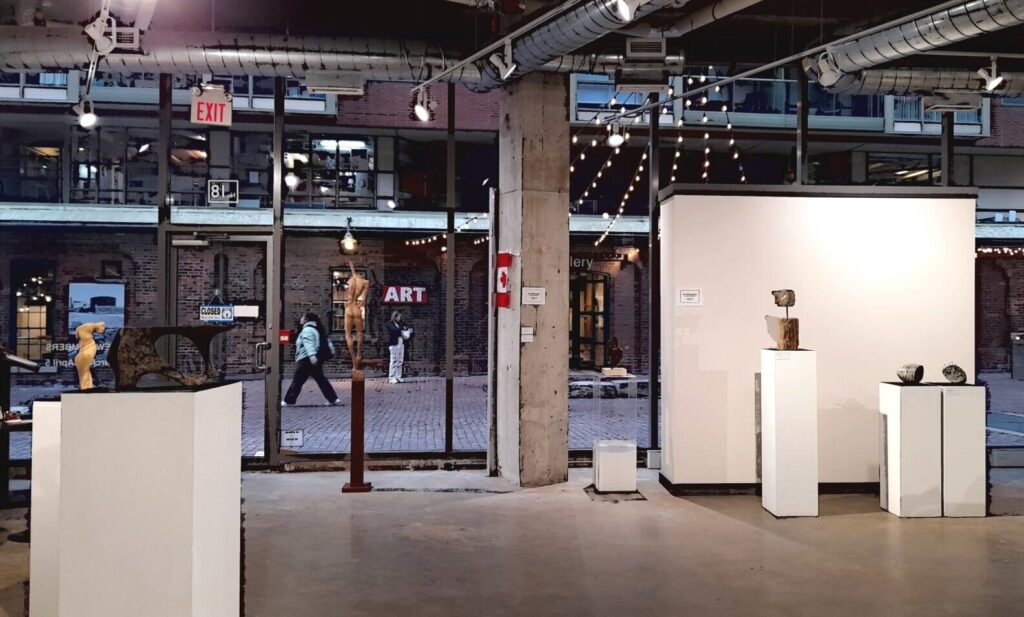As the Sculptors Society of Canada celebrates its 95th anniversary, the Canadian Sculpture Centre is forced to move once again. With relocation plans unknown, the gallery hosts its last exhibition at 18 Gristmill Lane in the Distillery District, “New Members”, highlighting emerging Canadian sculptors whilst honouring the Canadian Sculptors Society’s longevity and resilience.
The exhibition features the works of three sculptors from different parts of Canada, all of whom work with raw, natural materials – embracing prehistoric modes of artmaking while adopting crafted and handmade elements. Amid such turbulent times, where Artificial Intelligence attempts to generate art and mass-production is ever more dominant, this exhibit fittingly inspects the relationship between nature alongside the man and machine-made.
Installation view with Soheyl Bastami’s #2 – From Against the Wind Series (left)
Before even entering the gallery, I am greeted with Toronto-based artist Soheyl Bastami’s “#1 – From Against the Wind Series,” standing in the gallery window. Facing the historic road of the Distillery District, Bastami’s wooden figure showcases curiosity, pursuit, and survival as human instincts. While the identifying features of the body are bluntly whittled away, representing the mercilessness of nature, Bastami meticulously preserves the soft curves of the human form. Posed in an outstretched manner, the figure seems to embrace nature, however brute, while wanting more – yearning for knowledge and a deeper connection to it.
Soheyl Bastami, #1 – From Against the Wind Series, wood, steel
Figurative sculptures are a prominent element of Bastami’s recent work. With a background in graphic design, Bastami introduces a new and painterly way of deconstructing the human form in sculpture. For instance, the figure in “#2 – From Against the Wind Series,” is chiselled from a wooden plinth. With confident mark-making, Bastami challenges the initial refinement of the plinth. Although the figure is headless, I feel that I am caught in its gaze and even have a conversation with it. The figures of “#3” and “#5” from “Against the Wind Series” are delicate in comparison, resembling anatomical sketches or underpaintings. Bastami represents the power of the nature through the fragility of the figures, with broken away body-parts, and by embracing the rust and erosion of metal. Standing opposite to one another in the gallery space, the shadows these figures cast on the wall serve to animate them, breathing even more life into the work.
Soheyl Bastami, #5 and #3 From Against the Wind Series, steel
While Bastami’s figures seem to question the extent of human desire and exploration, Ottawa artist Dong Han is driven by ancient craftsmanship, seeking to determine the boundaries between man-made and natural artefacts. Here, Han accentuates the “warmth, safety, and vitality” of materials found in nature through rounded shapes and figures made of wood and bronze, mediums that Han refers to as “hard and cold.” Reducing the human face and body to its slightest implications, Han’s work bears similarity to prehistoric cave paintings and Paleolithic art. “Figure,” is a small wooden sculpture of a sexually ambiguous figure with no definite characteristics – yet, it remains undoubtedly human. Living up to its namesake, “Figure” could be everyone and no one, all at once – inviting viewers to create their own narratives.
Dong Han, Figure
Alternatively, in “Imprint” the artist reinterprets forms found in nature, resembling both a human limb and a tree branch or log. In these works, Han experiments with chemicals to transform the surface of bronze, producing abstract, watercolour-like paintings of landscapes. Through this process, Han generates visually stunning textures that, though chemically altered, feel inherent to the stone medium – engaging viewers to question the differences between natural and human creations.
Dong Han, Imprint, bronze
Likewise, Montreal artist Michel Dufresne examines the changes that occur to stone within its natural environment and through the creation of art. Dufresne compares the strength of stone in contrast to the fragility of glass, creating forms that highlight the natural beauty of these materials. The glass rods and beads of “Comme la terre” remain transparent and semi-reflective, encapsulating the man-made, whereas the crystals in the alabaster glisten under the gallery light.
Michel Dufresne, Comme la terre, alabaster, glass
Subsequently, “Rapprochement” and “Jonction” give the illusion of multitude. Although they are carved from one stone, Dufresne creates a mirage assemblage of several stones that, despite seemingly veering on the edge of collapse, never will fall – furthering the feeling of stability of the stone.
Michel Dufresne, Rapprochement, marble (in front)
Thoroughly investigating various facets of the human experience, ancient modes of creation, and how it all intertwines with the natural realm, the exhibit ultimately provokes reflection on our own interactions with history, art, and the environment. The “New Members” show offers an exciting array of new Canadian artists and an experience, sure to spark dialogues about the past, present, and future of contemporary sculpture.
Installation view with Gristmill Lane in the Distillery District
Text and photo: Tiffany Duong
*Exhibition information: New Members, March 2 – April 5, 2024, Canadian Sculpture Centre, 18 Gristmill Lane in the Distillery District, Toronto. Gallery hours: Tue – Sat 11 am – 6 pm, Sun 12 – 5 pm.

